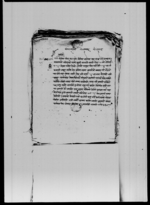A copy of a lālamohara from King Rājendra confirming Saṃkaradatta Jhā's appointment to the office of priest (VS 1887)
ID: K_0003_0017A
Edited by
Astrid Zotter
in collaboration with
Raju Rimal
Created: 2019-03-22;
Last modified: 2021-08-11
For the metadata of the document, click here
The accompanying edition, translation/synopsis and/or commentary are available under the terms of the Creative Commons Attribution-ShareAlike 4.0 International License
Abstract
This copy of a lālamohara from the king, who according to the date must have been Rājendra, confirms Saṃkaradatta Jhā from Thimi as a temple priest serving 50 households despite claims to that office by a wife of a deceased younger brother. Together with the hereditary right to enjoy the surplus revenue from 2 ropanīs of land, these privileges were granted to him as part of a ritual fee (dakṣiṇā) for having performed the puraścaraṇa of the mahāsahasracaṇḍī at the time of the Chinese invasion.Diplomatic edition
[324v]
1॥३२४॥⟪1३०६नं⟫⟪1सेनं३२३२२३2रुजु⟫[Unknown seal]1श्रीगाल•माहादव•
2१1श्री\५वाज्याज्यू•
2२1श्री\५वुवाज्यू•
2३1प्रस्तीसौ•
2आगे•थीमीका•संकर•दत्त•झाके•चिनिञाअऊदामामहा•सहश्र•चंदी•पुरश्चरण२
3लाषगर्याको•दछीनामध्ये•तहाको•वकुली•जजमानि•ठकालीभोघर५०डक्को•प्रोहीताई•
4र¯ ¯ १¯कोपुजा•काषेत•रोपनि•२तस्को•महसुल•स्मेत•मारी•मेटी•¯ ¯२ ¯वाट•सं•
5कल्पगरीवक्सनु•भय़ाको•रहेछ•अंतरमा•तहाका•अमाली•ले•कचपच•गरी•दीं•छं•भं•
6न्दा•ऊसो•भय़ा•संकल्पभय़ाकैरहेछ•भनि•ठहर्दा¯ ¯ ३¯वाटलाल•मोहरगरी•थामी•
7वक्सनु•भय़ाको रहेछ•विचमातीम्रोभाई•मनिझामरी•अपुतालीपर्यापछी•देऊवाभनकीने
8वार्नीतीर•कोछोरी•ल्याया•कोलेएस्मा•तहाम्रोपनि•लागछभनि•अमाली•हरूछेऊभं
9न्दा•आफु••माईति•भाडगाऊकोवुद्धीराज•भाजु•लाई•षवाऊडा•तिम्रोचीत•नवुझी•हाल्•
10काअमाली•छेऊ•भन्याछौर•हाम्राहजुरमा•विंन्तिपर्यो•तिमीले•पुरश्चरन•गर्दा•पाय़ा
11कोवीर्ताव़ा•कुलिजजमानि•ठकाली•डक्कोभोघर•५०र¯ ¯ १¯नित्य•पुजागरीषान्या•
12षेतरोपनि२अचारको•पैडाव़ारी•मध्ये•आधीली•षानुभनिअघीभय़ाको•मोहरव
13मोजीम•हामीलेपनि•थामी•वक्स्यौं•आफनाषातिर•ज्मासंगवृताजानी•संन्तान•
14दरसंन्तान•तेक•भोग्यगर•ईतीसंवत१८८७सालमीती•भाद्रवदी•१४रोज•३शुभ[Unknown seal]
Synopsis
[324v]
The royal document (lālamohara)1 of which this is copy addresses Saṃkaradatta Jhā2 from Thimi.
It states that the king's grandfather3 had made a ritual commitment (saṃkalpa) to grant—as part of a priestly fee (dakṣiṇā) for having performed two hundred thousand puraścaraṇas of the mahāsahasracaṇḍī4 at the time "when the Chinese came" (ciniñā aūdāmā)5 —the office of priest (jajamānī) over the south-eastern sector of the city,6 the priestly service (purohityāī̃) to 50 thakālī households7 and a field measuring 2 ropanīs linked to the worship (pūjā) of Śrī Gālamahādeva, a landholding exempt from the mahasūla tax. At some point the amālī of Thimi had quarreled and seized the land, but the king's father8 confirmed the earlier deed. Afterwards the addressee made petition to the king, stating that, after his younger brother Mani Jhā—who had taken a wife named Deūvā, a daughter of a Newar—died without a male heir and the latter, in claiming her inheritance at the amālī's office, had succeeded in allowing Buddhirāja Bhāju from Bhaktapur, who was a natal relative, to enjoy (parts of the holdings or the priestly office?). The document confirms the earlier lālamoharas, ruling that the addressee may enjoy the two ropanīs of land and (?) half of (?) (ādhīlī for adhilī?) the produce of vegetables (acāra?). He and his descendants should enjoy the birtā (text: vṛtā), conceiving it as theirs.
The document is dated Tuesday, the 14th of the dark fortnight of the month of Bhādra in VS 1887 (1830 CE).
Commentary
Due to a number of incomprehensible words and passages, the exact meaning of some portions of the present document remains obscure. For the copy of the earlier rukkā referred to in the present document and other documents related to this grant and the historical background to it, see the edition of K_0001_0039C.
The document attests to a quarrel over the rights and privileges granted to Śaṅkaradatta Jhā as a priestly fee for having performed a ritual at the time of the Chinese invasion (see K_0001_0039C for more on the ritual). Apparently, when his younger brother died without a male heir, his wife, who was of Newar descent, had claimed a right to have the worship performed, and had actually chosen for that purpose one of her relatives, Buddhirāja Bhāju, but the present document overturned her plans. This all implies that not only Śaṅkaradatta and his descendants but also his brother(s) were involved in fulfilling the ritual duties.
In order to understand the background and nature of this dispute over priestly services better, it would be necessary to find out which families and groups of Brahmins were in charge of performing household rituals in Thimi. The person who challenged Śaṅkaradatta Jhā/Vajhā's right, Buddhirāja Bhāju, probably was a Devabhāju, a Rājopādhyāya Brahmin,9 and thus the Newar lady probably came from a family of Rājopādhyāyas from Bhaktapur. Had the present office, then, been a former privilege of Rājopādhyāya Brahmins from Bhaktapur before being granted to Śaṅkaradatta Jhā/Vajhā, who evidently belonged to another Brahmin community, namely one whose members were of Maithili origin? Does the present document thus reflect a broader conflict between different Brahmin groups? How common was intermarriage between Rājopādhyāya and Maithili Brahmins at that time? These questions cannot be answered without access to further information.

